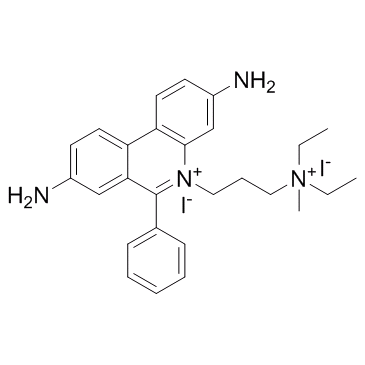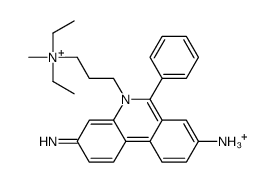25535-16-4
| Name | propidium iodide |
|---|---|
| Synonyms |
3,8-Diamino-5-[3-(diaethyl-methyl-ammonio)-propyl]-6-phenyl-phenanthridinium,Dijodid
propidium iodine 3,8-diamino-5-[3-(diethylmethylammonio)propyl]-6-phenylphenanthridinium diiodide 3,8-Diamino-5-{3-[diethyl(methyl)ammonio]propyl}-6-phenylphenanthridinium diiodide 3,8-Diamino-5-(3-Diethylaminopropyl)-6-Phenylphenanthridinium Iodide methIodide (3,8-diamino-5-(3-diethylmethylamino)propyl)-6-phenylphenanthridinium diiodide Propidium Iodide 3-(3,8-diamino-6-phenylphenanthridin-5-ium-5-yl)propyl-diethyl-methylazanium,diiodide EINECS 247-081-0 Propidium iodide solution Phenanthridinium, 3,8-diamino-5-[3-(diethylmethylammonio)propyl]-6-phenyl- , diiodide Phenanthridinium, 3,8-diamino-5-[3-(diethylmethylammonio)propyl]-6-phenyl-, iodide (1:2) MFCD00011921 3,8-diamino-5-[3-(diethyl-methyl-ammonio)-propyl]-6-phenyl-phenanthridinium,diiodide 3,8-Diamino-5-(3-(diethyl(methyl)ammonio)propyl)-6-phenylphenanthridin-5-ium iodide Propidium diiodide Propidium (Iodide) |
| Description | Propidium iodide is a red-fluorescent dye that can be used to stain cells. |
|---|---|
| Related Catalog | |
| In Vitro | Propidium iodide is a cell-membrane impermeable dye with characteristic excitation maximum at 535 nm and emission maximum at 617 nm which intercalates with nucleic acids with a stoichiometry of one dye per 4-5 base pairs with little sequence preference. Propidium iodide has evidenced of having no toxic effects on neurons, being today’s most common marker for membrane integrity and cell viability when applied prior to fixation (pre-fixation propidium iodide staining method). The pre-fixation staining has been widely used for quantitative assessments of neuronal cell decline in models of acute neurodegeneration, visualized as intensely labeled PI+-pycnotic nuclei of degenerating neurons [1]. Propidium iodide cannot cross the membrane of live cells, making it useful to measure the percentage of apoptotic cells by flow-cytometric analysis. The flow cytometric data shows an excellent correlation with the results obtained with both electrophoretic and colorimetric methods. This new rapid, simple and reproducible method proves useful for assessing apoptosis of specific cell populations in heterogeneous tissues such as bone marrow, thymus and lymph nodes[2]. |
| Cell Assay | Flow cytometric analysis: Propidium iodide is prepared in in 0.1% sodium citrate plus 0.1% Triton X-100 (50 μg/mL). The 200 ×g centrifuged cell pellet is gently resuspended in 1.5 mL hypotonlc fluorochrome solution (Propidium iodide 50 μg/mL), in 12×75 polypropylene tubes. The tubes are placed at 4°C in the dark overnight before the flow cytometric analysis. The propidium Iodide fluorescence of individual nuclei is measured using a FACScan flow cytometer. The nuclei traverses the light beam of a 488 nm Argon laser. A 560 nm dichrolc nurror (DM 570) and a 600 nm band pass filter (bandwidth 35 nm) are used for collecting the red fluorescence due to propidium Iodide staining of DNA and the data are registered on a logarithmic scale[2]. |
| References |
| Melting Point | 220-225 °C (dec.)(lit.) |
|---|---|
| Molecular Formula | C27H34I2N4 |
| Molecular Weight | 668.395 |
| Exact Mass | 668.087280 |
| PSA | 55.92000 |
| LogP | 0.15880 |
| Storage condition | 2-8°C |
CHEMICAL IDENTIFICATION
HEALTH HAZARD DATAACUTE TOXICITY DATA
MUTATION DATA
|
| Symbol |


GHS07, GHS08 |
|---|---|
| Signal Word | Warning |
| Hazard Statements | H315-H319-H335-H341 |
| Precautionary Statements | P261-P281-P305 + P351 + P338 |
| Personal Protective Equipment | Eyeshields;Gloves |
| Hazard Codes | Xi |
| Risk Phrases | 36/37/38 |
| Safety Phrases | S26 |
| RIDADR | NONH for all modes of transport |
| WGK Germany | 3 |
| RTECS | SF7949600 |
| Precursor 0 | |
|---|---|
| DownStream 1 | |



